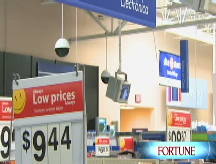Treasury yields fall to historic lows
Wary investors continue to flock to government debt as the economic outlook darkens.
NEW YORK (CNNMoney.com) -- Demand for U.S. Treasury bonds remained robust Thursday, with the yield on the benchmark note falling to an all-time low, as investors continue to flock to the safety of government debt.
With the global economy in turmoil and world financial markets in free fall, risky assets have fallen out of favor and investors appear to be mainly focused on preserving capital.
"Expectations for a deep recession/depression are feeding the fire of this bear market," said Bill Larkin, a fixed-income portfolio manager at Cabot Money Management in Boston.
In a sign of the market's jitters, the benchmark 10-year note jumped 2-29/32 to 106-14/32, and its yield slipped to 3.15% from 3.33% late Wednesday. The yield on the 10-year bond fell to 3%, its lowest level since the Treasury began offering the bond in 1962.
Meanwhile, the yield on the 3-month bill fell to 0.02% down from 0.07% on Wednesday. The last time the yield fell to this level was in September, at the height of the financial crisis, when it hit 0%.
The yield on the 3-month Treasury bill is closely watched as an immediate reading on investor confidence, with a lower yield indicating less optimism.
The 2-year note rose 5/32 to 101-1/32, and its yield fell to 0.97% from 1.07%, the first time the yield ever fell below 1%.
The benchmark yield curve, the difference between the 2-year and the 10-year yield, narrowed to 2.03 percentage points, down from a five-year high of 2.52 points set last Friday. The yield curve is a key measure of investor sentiment, with a higher curve indicating a weaker economic environment.
The 30-year bond rallied 8-17/32 to 118-24/32, and its yield fell to an all-time low of 3.48% from 3.92%.
Bond prices and yields move in opposite directions and falling yields suggest that investors are less concerned with profit and more focused on safety.
Economy: Thursday's rally comes against a backdrop of severe economic weakness. The global slowdown has pushed Japan and Europe into recession and many economists say the U.S. economy is in a de-facto recession.
Recession fears were stoked Thursday by a Labor Department report that showed weekly jobless claims surged to a 16-year high last week. The grim reading on the labor market weighed on the stock market, with the Dow Jones industrial average tumbling below 7800 points in early trade.
As the economy deteriorates, investors have become more willing to forego big profits in exchange for the safety provided by U.S. Treasury bonds. Treasurys are seen as safe bets since they come with government backing.
"When panic comes and investors are forced to liquidate large portfolios, they go into the Treasury market," Larkin said.
At the same time, the outlook for inflation has significantly moderated as energy prices have eased. Treasurys are highly inflation-averse, since rising prices erode the value of fixed-income assets.
Some economists expect inflation rates to turn negative in the near further. That, combined with the flight to quality aspect, could drive the yield on the 10-year note below 3%, according to Larkin.
Another gauge of market sentiment, the TED spread, fell slightly to 2.09 percentage points from 2.10 points. The TED spread measures the difference between the 3-month Libor and the 3-month Treasury bill, and is a key indicator of risk. The lower the spread, the more willing investors are to take risks.
Lending rates: Separately, bank lending rates were mixed Thursday as the credit crisis continues to chill the market.
The 3-month Libor rate fell to 2.15% from 2.17% Wednesday, and the overnight Libor rate was unchanged at 0.44%, according to Bloomberg.com.
Libor, the London Interbank Offered Rate, is a daily average of interbank lending rates and a key barometer of liquidity in the credit market. More than $350 trillion in assets are tied to Libor.
A key measure of banks' confidence in the credit market suggested that their purse strings are still tied.
The Libor-OIS spread widened to 1.73 from 1.71. The spread measures the difference between actual borrowing costs and the expected targeted borrowing rate from the Fed. It is used as a gauge to determine how much cash is available for lending between banks. The bigger the spread, the less cash is available for lending. ![]()



